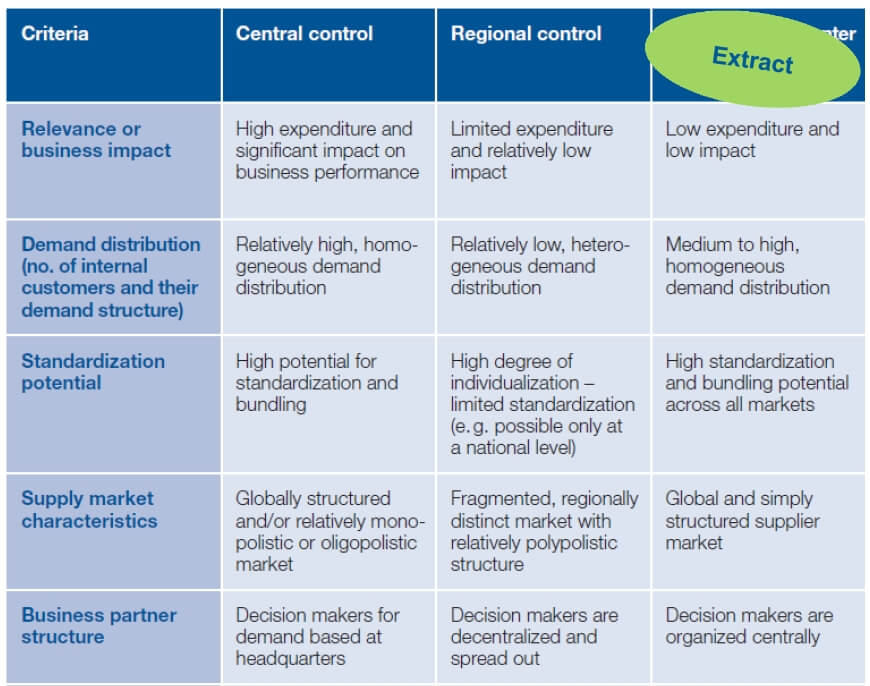How to set up your procurement for the future. A roadmap for transforming procurement.
Successful companies grow. In the wake of rapid growth, one component is often neglected: the adaptation of procurement structures. Our roadmap shows how internationally established companies develop the optimal organization for their procurement in order to maintain their success.
If growth is regarded as a company’s main priority, the job of procurement seems very clear: to ensure secure supply. However, the circumstances and effort necessary to achieve this are usually given less importance than more urgent management issues. It is implicitly assumed that procurement has unlimited scalability and does not need to be developed, because larger quantities will simply be procured as required on an individual basis. This can lead to problems, especially when new markets are opened up, product variety is increased, and/or regular suppliers are pushed to the limits of their capacity. This is the point where new and/or wider supplier structures need to be established and existing relationships need to be improved. Without further procurement development, growth targets may not be achievable.
While procurement does not drive company growth, it might turn into a preventer of growth if not built up accordingly. In particular, companies often do not focus enough on managing the procurement of indirect spend – in other words, services, capital goods and consumables – which are required throughout the organization but are not directly used in the value creation process. This can put growth at significant risk in globalized structures if, for instance, logistic processes come to a halt, or temporary staff required for production are not available. New questions may come to the center of attention as a result: how can indirect procurement be restructured for future demands? What decision-making criteria are used as a basis for good procurement organization, and how can they be implemented? When are centralized, decentralized or hybrid structures suitable, and to what extent should strategic, tactical and operational procurement be differentiated?
Transparency with the spend cube
After dynamic growth phases, it is often the case that inefficient structures and dependencies have formed that can no longer be well organized. Here too, it is often indirect procurement that has not been sufficiently developed: spending, which does not directly affect production, such as professional services, IT, marketing, construction, or logistics, can easily be procured autonomously by branch offices and/or the business units that use them. This can happen especially if existing procurement is pushed to its limits in the wake of increasing volumes or is halted by operational processing.
The amount of maverick buying increases, and the following all fall short: company-wide expenditure transparency, standardized processes and contracts, homogenized supplier portfolios and a strong bargaining position with suppliers. As a result, procurement optimization projects typically start with the creation of a ‘spend cube’, which breaks down purchasing volumes, demands, the involved stakeholders on procurement and suppliers side, and serves as a basis for devising optimization approaches and potentials.
Key questions in this phase are: who orders what, how often, in what quantity, at what price, when and where? Using an established method, suppliers, internal stakeholders and product segments can be identified. Based on this, supplier markets, as well as product groups and their sub-segments, can be classified and – in the context of developing future demands – rated and evaluated. Analysis of the current situation and creation of meaningful procurement demands can then take place individually for each product group or requirement category.
Organizational direction according to requirement category
Procurement activities are divided into strategic, tactical, and operational tasks. In terms of developing the procurement organization, it can be useful to define the structural design for every category along these lines.
It may also be advisable to consider strategic procurement globally or centrally, even though tactical procurement measures are implemented regionally for certain product categories. With operational processing, it is possible for users to carry out procurement tasks, provided digital tools enable extensive automation and only minimal operating expenses are necessary. In the case of more manual tasks, procurement service centres or outsourcing partners in low-wage locations could take on core operational tasks such as procurement requisitions.
Allocating tactical tasks is more difficult in this context. It can be determined by a variety of criteria, as shown in the following table. One aspect is the relevance of spending to the company. Passing on work to a shared service center or outsourcing tactical procurement for categories with low impact on the company’s success, such as office supplies, may be preferable to categories that are more relevant to business, such as marketing services for brand-name companies. Also some spendings can be covered centrally for the best cost-efficiency within global framework agreements, while others should be managed locally and individually. As well as ‘relevance’, criteria such as demand distribution, standardization potential, procurement market characteristics, business partner structure (decision making within users), complexity and market pricing, must all be considered together to help establish tactical responsibility.

Please download the full article to receive all graphics included.
If there is a particular demand that is only required at one location, such as archiving technical documents and drawings from R&D, company-wide central procurement for this subcategory is not necessary. If demands are the same at several locations, procurement market characteristics are an important factor. In cases where global procurement market structures and high standardization potential can make a difference, for example with media services, IT hardware, travel or CEP logistics, central procurement is better. Regionally distinct markets, such as in the field of electrical installation, where companies may work within a radius of 100 km, are not suited to a global level of control. In the case of global demands that are supplied from one single procurement market, such as window mannequins from China, lead buyer approaches can be profitable, where the corresponding location is tactically responsible for the whole group’s spendings in the target procurement market.
These conceptual considerations show how complex the design of a sustainable procurement organization for internationally established companies can be. It is even more important to deal with the topic quickly, before growth and a healthy order situation become fatal for procurement and for profitability.
Read the full article to find out…
- How to achieve the necessary transparency with each demand category
- What role HR sizing plays in sustainable procurement
- How a cost-to-benefit comparison for restructuring procurement organization looks like
Please fill out the form to download the full article:
